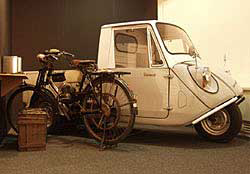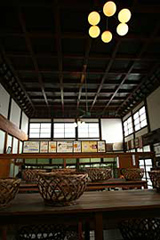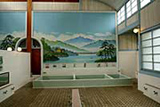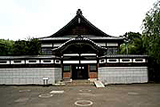 |
 |
 |
The Edo-Tokyo Open Air Architectural Museum:
Taking a Stroll Through History
Alan Gleason |
 |
 |
 |
 |
| A three-wheeled delivery truck and motorized bicycle, standard transport in Tokyo fifty years ago (on display with other artifacts of Tokyo life in the 1950s until September 3, 2006). |
 |
When friends visit Tokyo from overseas, I take them to the Edo-Tokyo Open Air Museum, or Tatemono-en, located in Koganei Park a few miles west of downtown. Not just an architecture bufffs paradise, itfs a lovely place for a walk and educational in the bargain. Buildings of all varieties and from all epochs of the cityfs history have been assembled here, ranging from thatch-roofed farmhouses to aristocratsf villas to quasi-Western, copper-sheeted storefronts a century old. The gmain streeth of classic Meiji, Taisho, and early Showa era shops, still open for business, culminates in the biggest public bathhouse I have ever seen. So inspired by the sight were the designers at nearby Ghibli Studios that they made it the model for the bathhouse in their hit animated film "Spirited Away". At the more sober end of the cultural spectrum, you can sip tea, slurp soba, and gaze out on the tranquil garden at the mansion of statesman Korekiyo Takahashi -- assassinated in that very house during a 1936 military coup. The visitor center also boasts a small gallery, currently featuring images and artifacts of Tokyo in the fifties.
 |
 |
 |
 |
 |
 |
 |
| The Kodakara-yu public bathhouse at Tatemono-en, built in the early Showa era and more recently an inspiration for the film gSpirited Away.h |
|
|
 |
 |
 |
Edo-Tokyo Open Air Architectural Museum (Tatemono-en) |
 |
http://www.tatemonoen.jp/index.html (Japanese only) |
 |
3-7-1 Sakuracho, Koganei-shi, Tokyo
Phone 042-388-3300 |
 |
Open 9:30-5:30 (April-September), 9:30-4:30 (October-March)
Closed Mondays and during New Year holiday
Admission: 400 yen (general)
Transportation: Buses available from JR Higashi-Koganei, JR Musashi-Koganei, and Hana-Koganei (Seibu-Shinjuku Line) stations |
 |
|
 |
 |
Alan Gleason
Alan Gleason is a translator, editor and writer based in Tokyo, where he has lived for 22 years. In addition to writing about the Japanese art scene he has edited and translated works on Japanese theater (from kabuki to the avant-garde) and music (both traditional and contemporary). |
|
|
|
 |
|